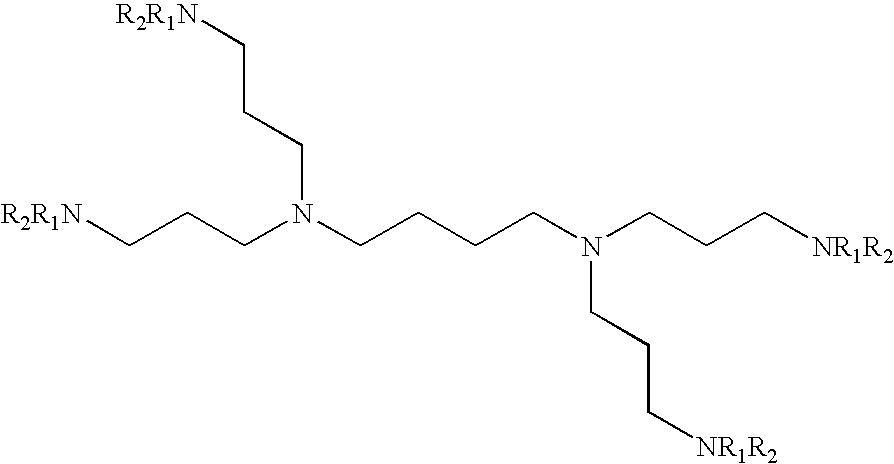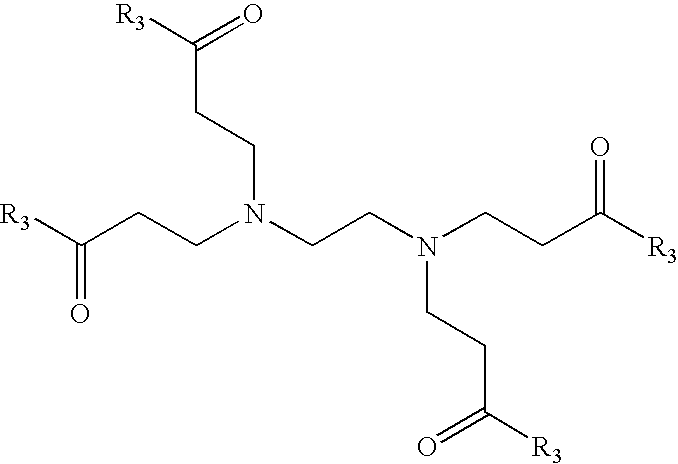Method of clarifying oily waste water
a technology of oily waste water and wastewater, which is applied in the direction of water/sewage multi-stage treatment, separation process, treatment water nature, etc., can solve the problems of increased operational costs of the industry involved, reduced production, and very often unavailable equipmen
- Summary
- Abstract
- Description
- Claims
- Application Information
AI Technical Summary
Problems solved by technology
Method used
Image
Examples
example 1
Evaluation of Representative Demulsifiers in the Petrochemical Industry
[0064]The treating efficiency of representative demulsifiers according to this invention is evaluated on-site at several locations in the United States and Canada. In all tests, a process sample is collected and used within 30 minutes. Each process sample is divided into 50 mL aliquots and these aliquots are placed into six-ounce bottles. One six-ounce bottle is left untreated and the other bottles are dosed with the target dosage of the product being tested. Each test site compares representative demulsifiers of this invention with current emulsion breakers. The current emulsion breakers tested include, all available from Nalco Company, Naperville, Ill.:[0065]a) Commercial I—solution polymers such as dimethylamine-epichlorohydrin (DMAEM)-ammonia terpolymer or DMAEM homopolymers;[0066]b) Commercial II—dispersion polymers such as quaternary ammonium salts prepared by reaction of benzyl chloride with dimethylaminoe...
example 2
Evaluation of Water Clarifiers in the Oilfield.
[0074]The efficiency of representative demulsifiers for clarifying oilfield-produced water is also evaluated on site at several locations in California and Wyoming. Two to five gallons of oil field produced water are collected and used within the next two to four hours depending on the emulsion stability. Six ounce clear glass bottles are filled with 100 mL of water and inverted several times to coat the bottles with the emulsified fluid. The treating chemicals are added to individual bottles as one percent aqueous solutions.
[0075]Immediately after dosing, bottles are capped, labeled and agitated. The samples are all agitated identically to simulate turbulence in the system. The samples are hand shaken in sets of six either 50 or 100 times depending on the emulsion stability, and water clarity is visually evaluated through several sets of agitations (usually 2 to 3).
[0076]One bottle is left untreated and the other bottles are dosed with...
PUM
| Property | Measurement | Unit |
|---|---|---|
| molecular weight | aaaaa | aaaaa |
| molecular weight | aaaaa | aaaaa |
| molecular weight | aaaaa | aaaaa |
Abstract
Description
Claims
Application Information
 Login to View More
Login to View More - R&D
- Intellectual Property
- Life Sciences
- Materials
- Tech Scout
- Unparalleled Data Quality
- Higher Quality Content
- 60% Fewer Hallucinations
Browse by: Latest US Patents, China's latest patents, Technical Efficacy Thesaurus, Application Domain, Technology Topic, Popular Technical Reports.
© 2025 PatSnap. All rights reserved.Legal|Privacy policy|Modern Slavery Act Transparency Statement|Sitemap|About US| Contact US: help@patsnap.com



